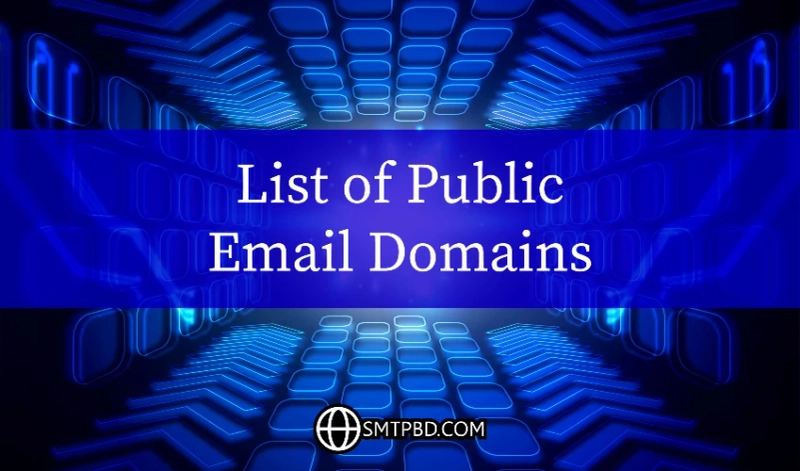Photo By Navigating the List of Public Email Domains
List Of All Public Email Domains, email remains a cornerstone of communication. Whether for personal correspondence or professional communication, understanding the landscape of public email domains is essential. In this comprehensive guide, we’ll explore a curated list of public email domains, shedding light on the diverse array of platforms that individuals and businesses use to connect with the world.
The Significance of Public Email Domains
Universal Communication:Public email domains serve as the backbone of universal communication. They enable individuals and organizations to exchange messages, collaborate, and share information seamlessly across the internet.Professional Identity:
For businesses and professionals, a custom email address with a public domain enhances credibility and establishes a professional identity. It adds a layer of authenticity to communication, instilling confidence in recipients.Global Connectivity:
Public email domains facilitate global connectivity, breaking down geographical barriers. Whether it’s sending a quick note to a colleague or conducting international business, email domains play a pivotal role in fostering a connected world.
A Curated List of Public Email Domains
1. Gmail:
gmail.com2. Yahoo:
yahoo.com3. Outlook:
outlook.com4. AOL:
aol.com5. ProtonMail:
protonmail.com6. Zoho Mail:
zoho.com7. Yandex Mail:
yandex.com8. Mail.com:
mail.com9. GMX Mail:
gmx.com10. iCloud Mail:
icloud.com11. FastMail:
fastmail.com12. Tutanota:
tutanota.com13. Mail.ru:
mail.ru14. Hushmail:
hushmail.com15. Airmail:
airmail.net16. Lycos Mail:
lycos.com17. Netcourrier:
netcourrier.com18. Zimbra:
zimbra.com19. Rediffmail:
rediffmail.com20. Mailinator:
mailinator.comChoosing the Right Email Domain
Personal Use:
For personal use, popular public email domains like Gmail, Yahoo, and Outlook offer user-friendly interfaces, ample storage, and a range of features. Choose based on preferences and familiarity.Professional Branding:
Businesses and professionals often opt for custom email addresses with domains matching their brand. This enhances brand visibility, professionalism, and trust among clients and partners.Security and Privacy:
Platforms like ProtonMail and Tutanota prioritize security and privacy. If these aspects are critical for your communication needs, considering such providers is crucial.Collaboration Tools:
Some email providers, like Zoho Mail and Google Workspace, offer integrated collaboration tools. If seamless collaboration and document sharing are priorities, explore platforms that provide these features.Specialized Needs:
Depending on specific needs, individuals and businesses might choose specialized email providers. For example, Hushmail is known for its focus on secure communication, while Mailinator offers disposable email addresses.
Trends and Innovations in Email Domains
Custom Domain Extensions:With the introduction of new domain extensions (e.g., .tech, .app), individuals and businesses have more options for customizing their email addresses. This trend allows for unique and memorable email domains.Integrated Communication Platforms:
The integration of email with other communication and collaboration tools is a growing trend. Platforms like Microsoft 365 and Google Workspace offer a suite of applications, fostering a centralized hub for communication and productivity.Enhanced Security Features:
As cyber threats evolve, email providers are focusing on enhancing security features. Two-factor authentication, end-to-end encryption, and advanced threat detection are becoming standard offerings.Artificial Intelligence in Email:
Some email platforms are incorporating artificial intelligence (AI) to enhance user experience. AI-powered features include smart replies, predictive email categorization, and automated email sorting.
Best Practices for Email Usage
Strong Passwords:Ensure that your email account is secured with a strong, unique password. Consider using an admixture of upper and lower case letters, numbers, and symbols.Regular Security Checks:
Periodically review and update your security settings. Enable two-factor authentication if available, and monitor login activity to detect any unauthorized access.Avoiding Phishing Scams:
Be cautious of phishing scams. Avoid clicking on suspicious links or provide sensitive consult in response to unwanted emails. Verify the validity of emails, especially those requesting personal information.Managing Email Preferences:
Take control of your email experience by directing your email preferences. Unsubscribe from unwanted newsletters, use filters to organize incoming emails, and regularly clean up your inbox.Backup Important Emails:
Regularly back up all-important emails to prevent data loss. Most email providers offer options for exporting and archiving emails, ensuring that critical information is safeguarded.
Conclusion
List Of All Public Email Domains, the choice of email domain is a pivotal decision that influences communication, identity, and security. The curated list of public email domains provides a glimpse into the diverse options available, catering to a spectrum of needs.
As individuals and businesses navigate the email landscape, staying informed about trends, adopting best practices, and choosing the right email domain for specific purposes are crucial steps. Email remains a fundamental tool for connection, and the choices made in this realm significantly impact the efficiency and security of digital communication.


